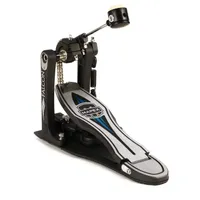Best bass drum pedals 2025: single and double bass pedals for every budget
Put your best foot forward with my guide to choosing the right kick pedal for your playing style and budget, with picks from DW, Pearl, Tama, Yamaha and others
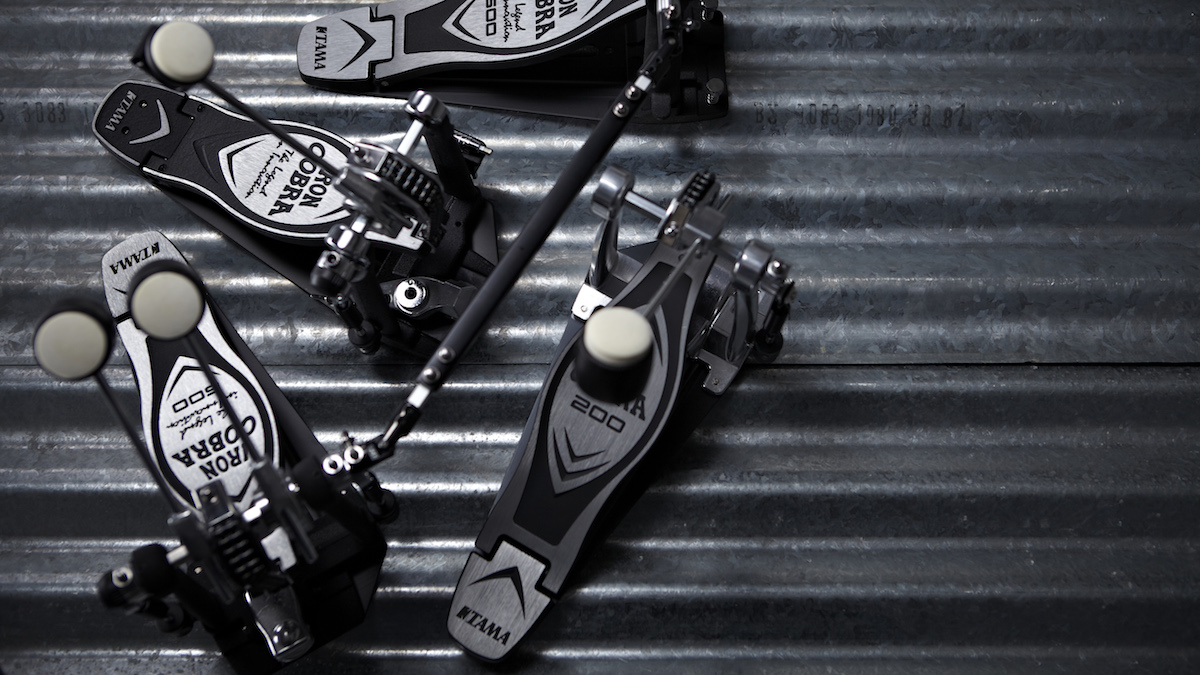
Besides your drumsticks, your pedals are the most crucial link between you and your kit. With the kick drum being such a central aspect of all drumming styles, it's important that you have the best bass drum pedal for the task, whatever style of music you play.
Just like your sticks, the type of pedal and beater you add to your arsenal is a hugely personal thing, and finding the right bass drum pedal for you can dramatically impact (and hopefully improve) the way you play.
With such a huge range of pedal brands, pedal types and price ranges to choose from, it can be hard knowing which pedal to go for. My guide is designed to help you zero in on the best option for you - whether you’re seeking out chain, direct or belt-drive, to single and double variants. Other notable features to consider are the cam type that shapes the way the beater moves through its travel, plus footboard length, beater type and more. I’ve included more on this in the FAQs section.
It’s likely that a pedal upgrade will be a fairly long-term investment for you, so it's important to find a pedal which feels comfortable to play and complements your playing style. In this guide I’ve included options for every budget, but right now my number one recommendation is the Tama Iron Cobra 900 model, which delivers the perfect blend of speed and power.
My top picks
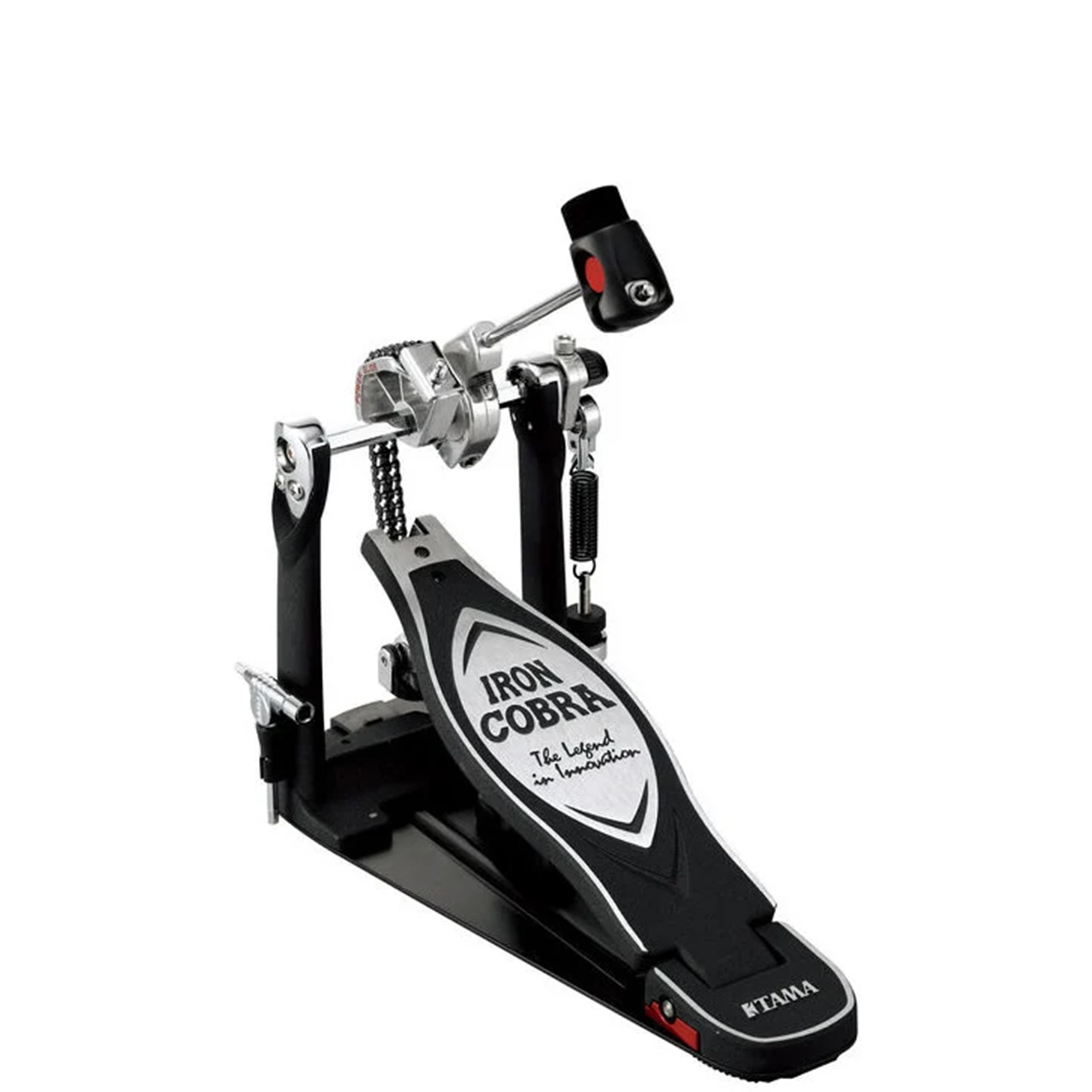
The Iron Cobra is designed to meet not only the demands of the modern drummer, but also fulfil its clear mission statement of "rock solid strength and versatility". I concur.
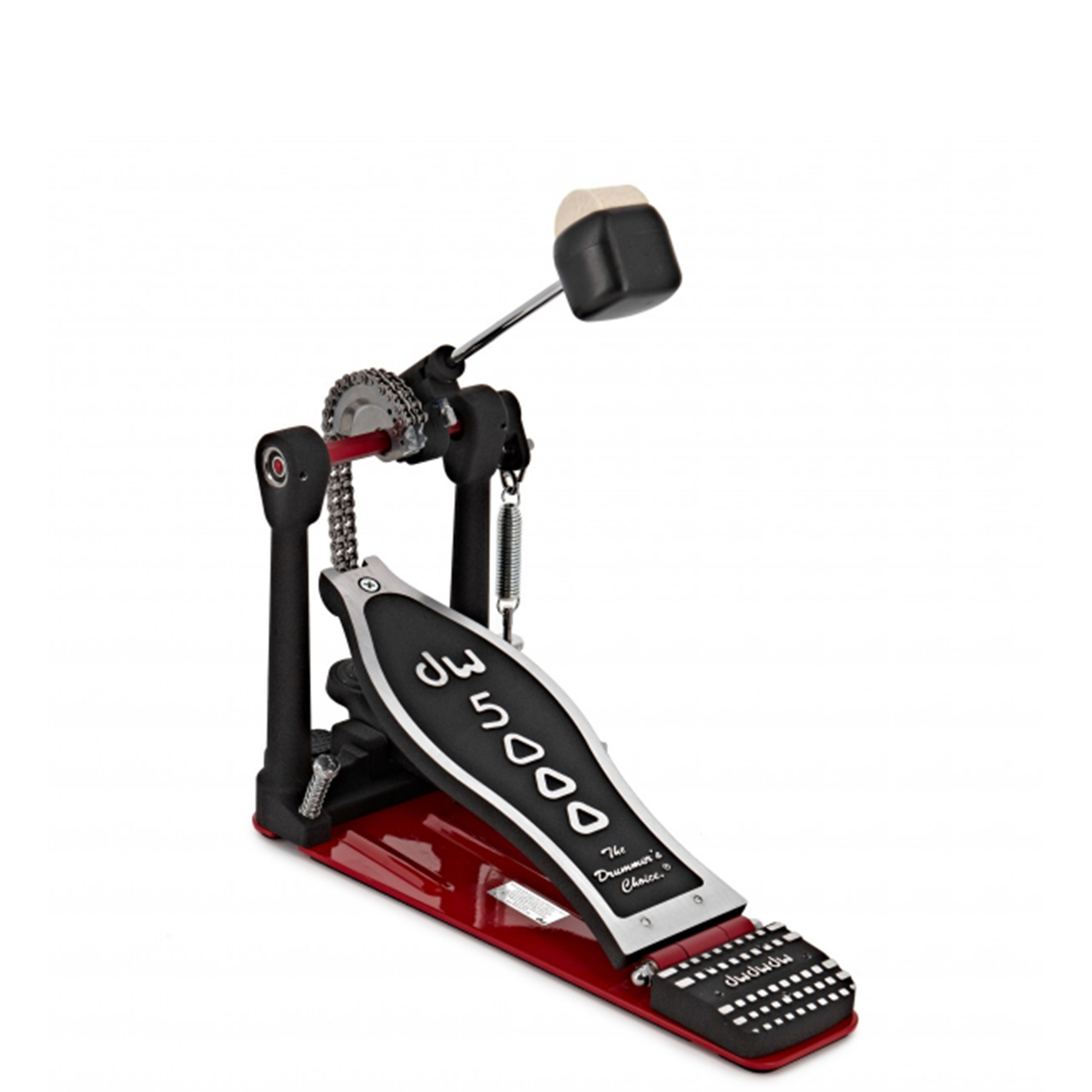
The 5000 is very much a standard in the bass drum pedal market, offering premium power, speed and adjustment. It’s a monster of a pedal that should last you years.
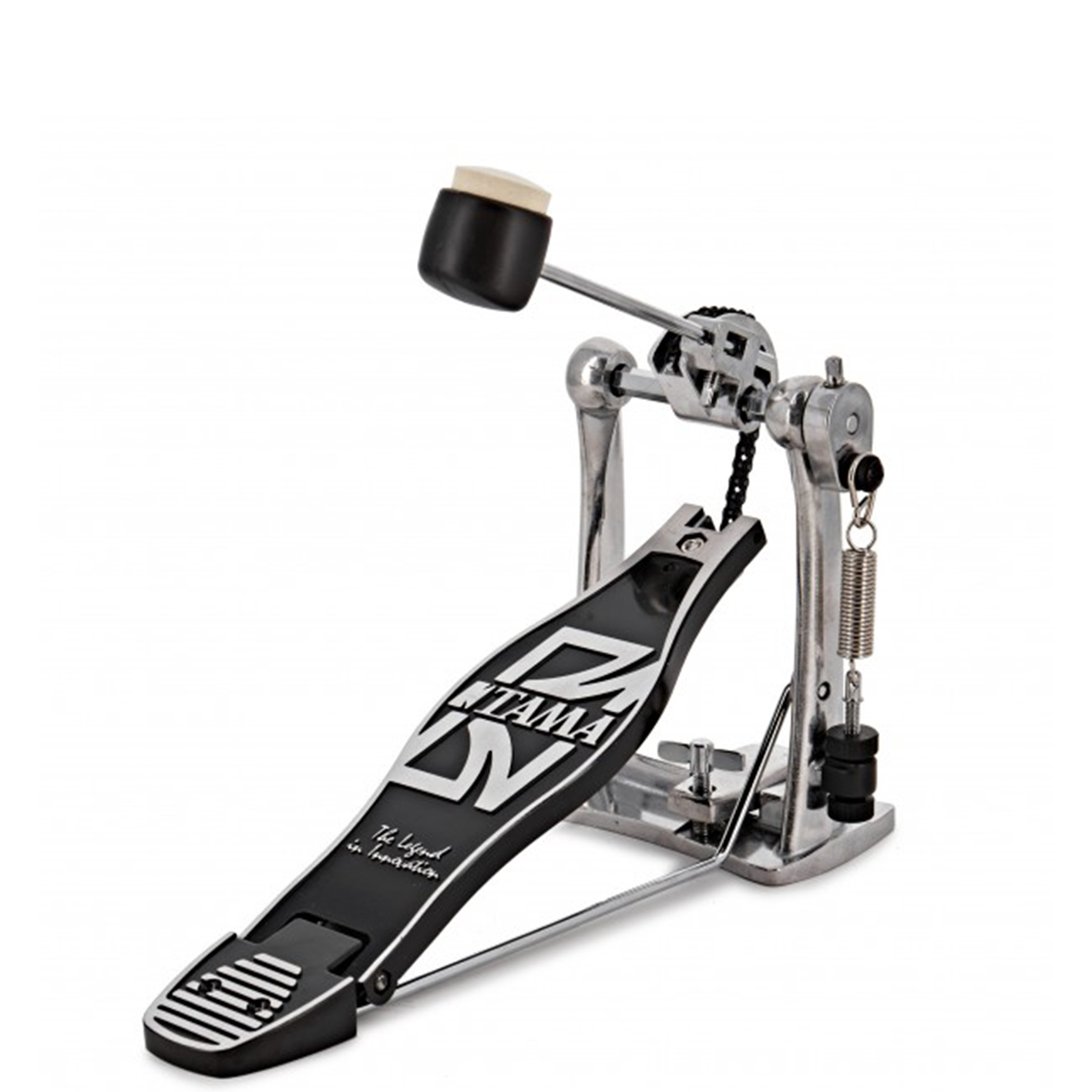
While this pedal might not have the same level of adjustability or the Iron Cobra footplate for that extra stability, the HP30 certainly offers bang for your buck. An ideal bugdet or beginner pedal.
Best overall
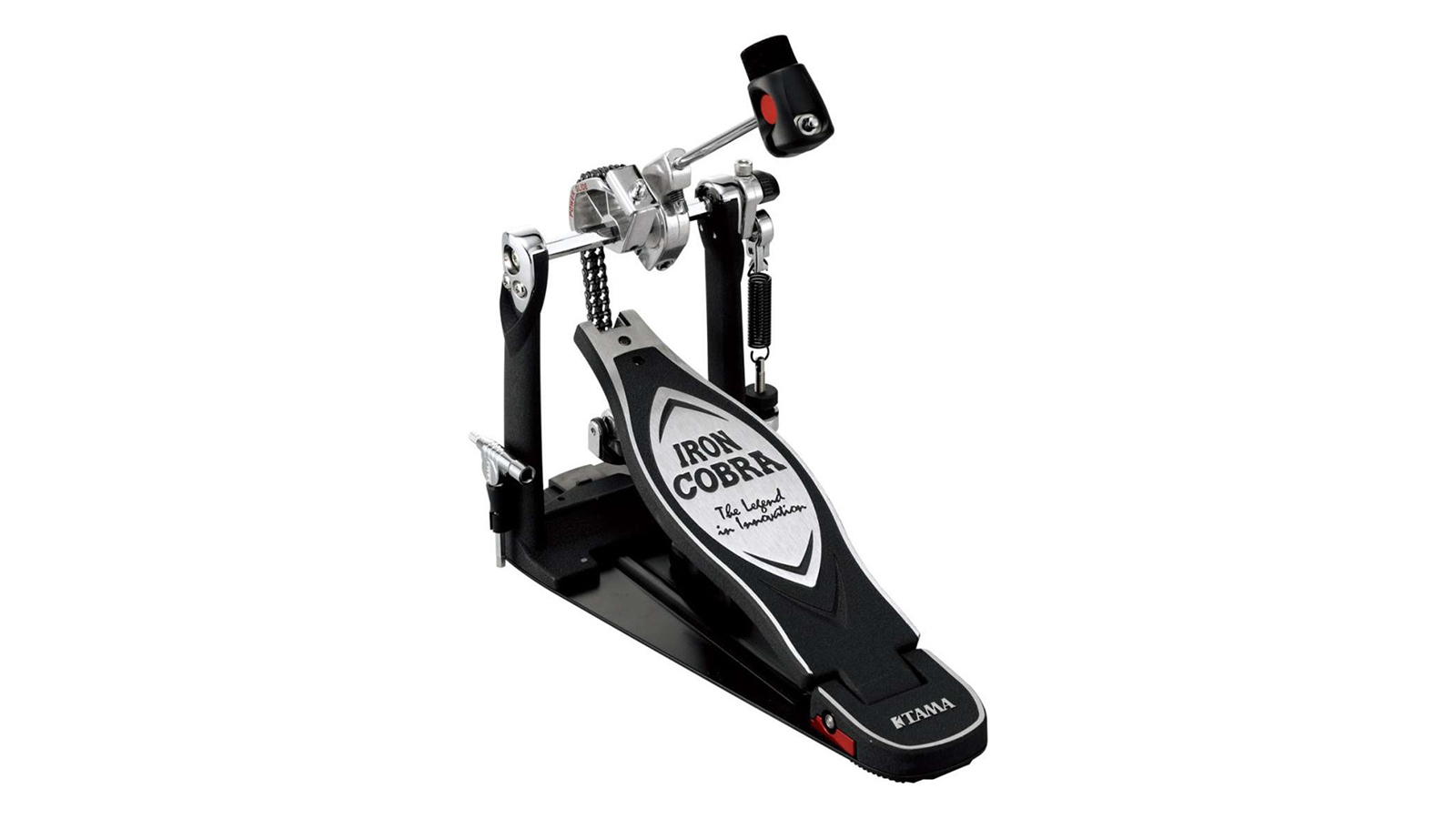
Specifications
Reasons to buy
Reasons to avoid
Since its introduction over 30 years ago, the Iron Cobra pedal has continued to evolve and improve to meet not only the demands of the modern drummer, but also its clear mission statement: "rock solid strength and versatility".
The latest incarnation features a wider footplate and frame to eliminate side-to-side motion, updated lightweight cams (inherited from the Speed Cobra) in both Rolling Glide (linear) or Power Glide (offset) shapes. A smaller Power-Strike beater head design uses dense foam in place of felt for maximum punch. In addition, the Iron Cobra is fitted with Tama’s Cobra Coil to help make the pedal feel lighter, even at higher spring tension settings, and the whole pedal offers plenty of adjustment including beater angle, beater face angle, spring tension, footplate height.
As always, the Iron Cobra 900 series comes in a hardshell plastic case for safe transportation.
Read more: Tama Iron Cobra 900 review
Best for gigging

Specifications
Reasons to buy
Reasons to avoid
Like the Tama Iron Cobra, the DW 5000 inherits DNA from the Camco designs of the 60s - both companies have owned the brand name at different times.
Drum Workshop’s current 5000 series pedals are available in a range of options: Accelerator or Turbo Drive, heel-less (5000ADH), extended footboard (5000 XF) and single-chain (5000 AH4). Here we’re focused on the more regular AD4/TD4, which both feature a dual-chain design with either linear or offset cams.
The 5000 is very much a standard in the bass drum pedal market, offering premium power, speed and adjustment. The sturdy baseplate features non-slip rubber to hold the pedal in place, and features such as the Dual-Bearing Spring Rocker, Tri-pivot clamp and single-post design (for easy slave pedal placement) all help the 5000 to fit into your setup and offer all the customisation you could need. It’s a monster of a pedal that should last you years.
Read more: DW 5000 bass drum pedal review
Best budget
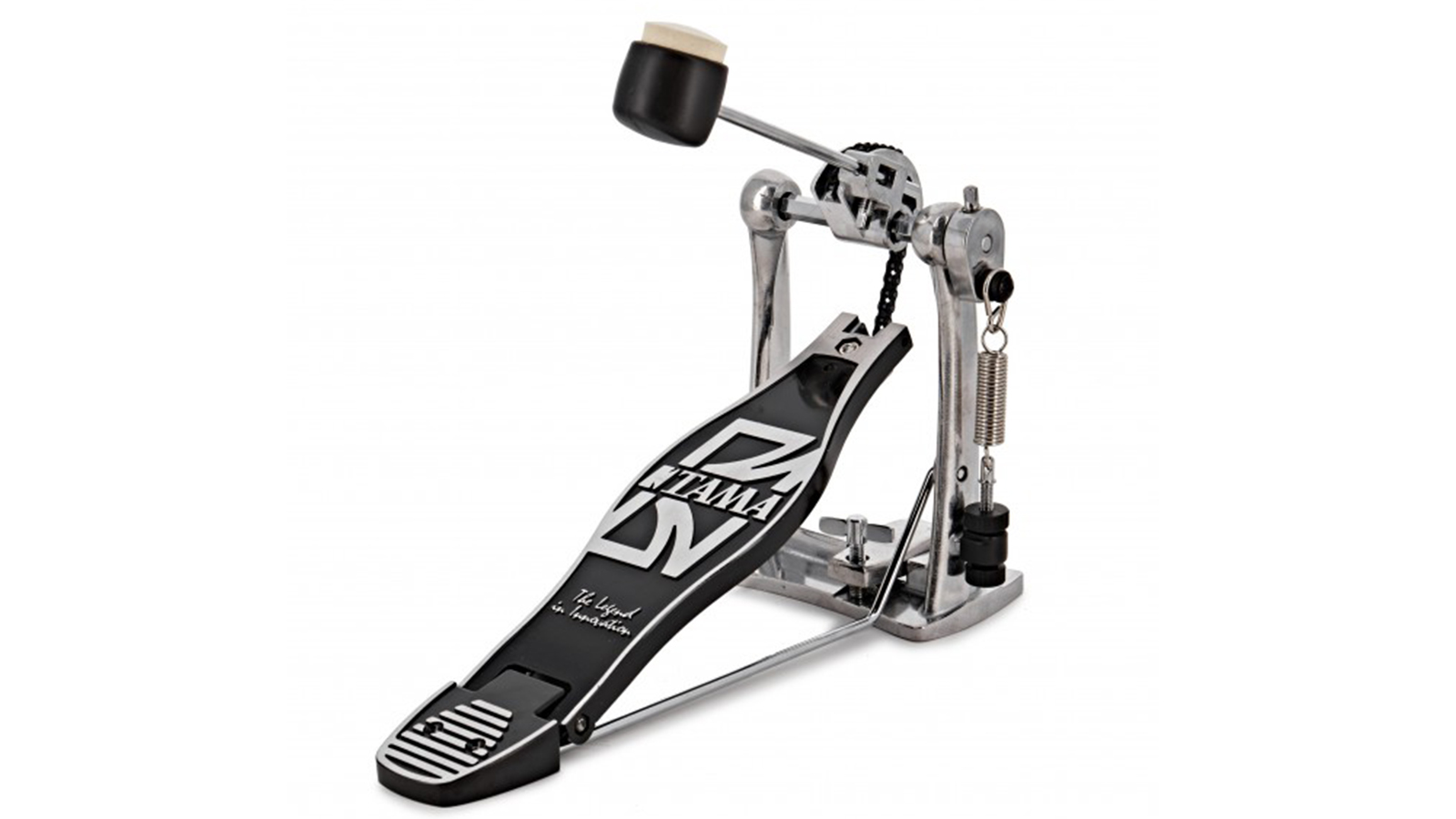
3. Tama HP30
Our expert review:
Specifications
Reasons to buy
Reasons to avoid
The Tama HP 30 is sometimes called the “baby Iron Cobra”, because of how similar it looks to its more expensive older brother. How apt then, that the similarities don’t end there. While it might not have the same level of adjustability or the footplate for that extra stability, the HP 30 certainly offers bang for your buck.
The spring tension is excellent, offering beginners and semi-pros alike that snappy, responsive feeling that Tama is known for. The build quality is undeniable, with a robust footplate, and a weighty beater that will suit funk, rock or hip-hop players.
At such a low price-point, this is the perfect foray into the world of decent quality pedals for beginner drummers, and would even make a great backup for the seasoned pro; although in my opinion it wouldn’t suit hardcore touring.
Best for adjustment

Specifications
Reasons to buy
Chain or belt options
Reasons to avoid
Pearl's famous Eliminator pedals have become a popular choice among professional and amateur drummers alike, and this popularity can be put down to their trusted reliability and the sheer scope of customisation available. The Eliminator Redline takes this to the next level. Original Eliminator features include the patented interchangeable cams (the pedal comes with four but two others are available) and the 'Powershifter' function which allows the entire footboard to be moved up and down on the base. Shiny ‘Redline’ additions include Control Core Quad beaters (two felt sides and two plastic), Click-Lock Spring Adjustment and NiNja precision axle bearings.
The latter are established skateboard bearings, as used in Pearl's flagship Demon Drive pedals. According to Pearl, this new functionality allows the Redline to perform 85 percent better than its predecessor in velocity testing.
The Redline is available as a chain or belt-drive option, both as single or double versions. Despite the almost infinite scope for customisation, the Redline performs well straight out of the box, with the interchangeable cams really making a difference to the pedal’s feel. It can take a long while to work your way through each variation and choose a preference, but for those willing to tinker away the hours finding their perfect set-up, there really is a pedal for everyone in the Pearl Eliminator Redline. So much so, that I had one stolen from my car only a month after I purchased mine. Lock your doors folks!
Best for speed
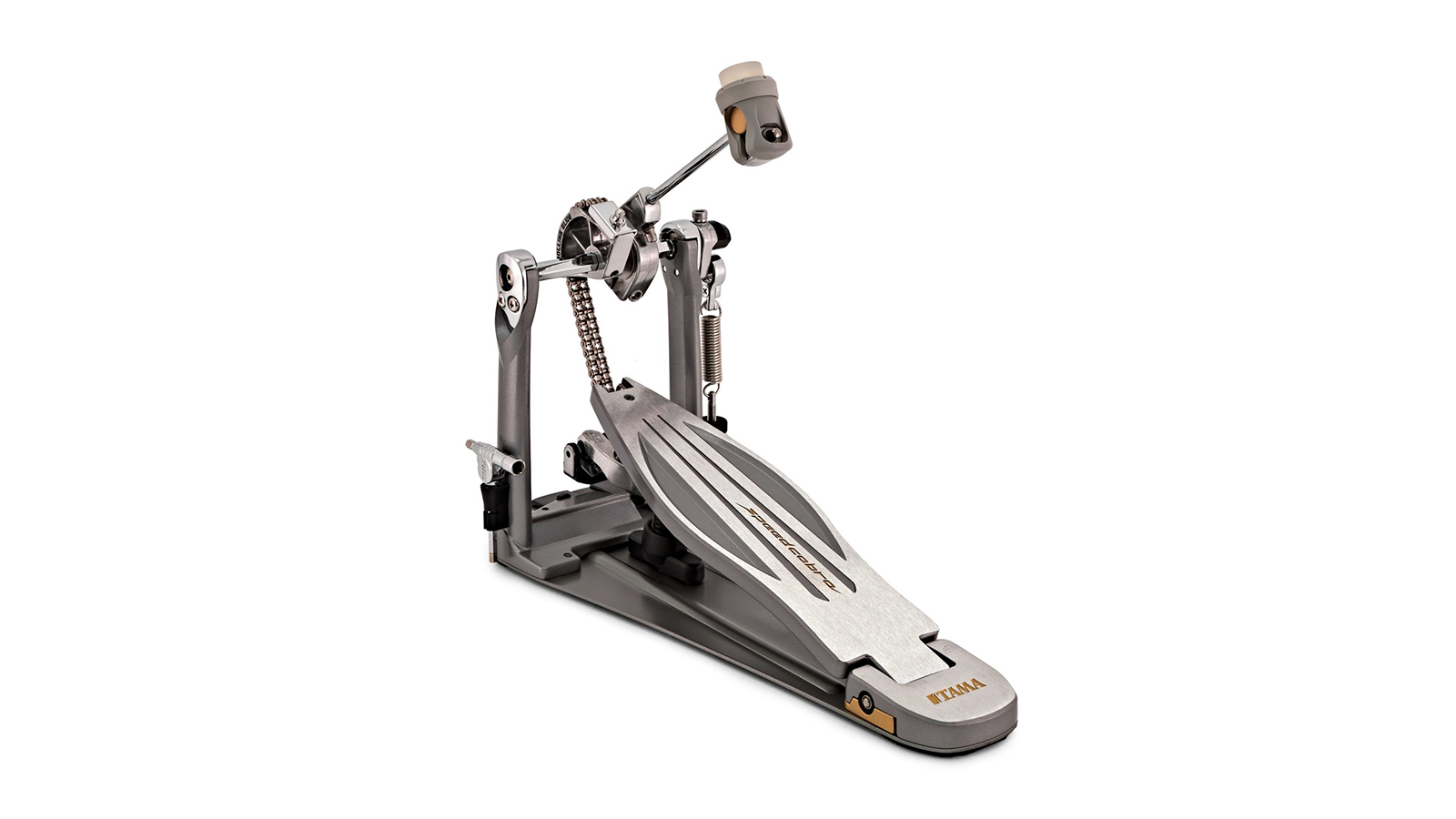
Specifications
Reasons to buy
Reasons to avoid
The Tama Speed Cobra shares many features with the Iron Cobra, such as the Speedo ring, Vari-Pitch beater head, Oiless bearing hinge, Cobra Coil and more. However, the Speed Cobra is designed to feel lighter than the Iron Cobra, with the whole lot geared-up to respond like a Cobra after a couple of shots of espresso.
The footboard is longer, and the pedal is available with Tama’s Rolling Glide cam only. The idea being that the linear response helps maintain higher playing speeds without any additional resistance from the pedal. Unsurprisingly, the Speed Cobra has a lighter feel to the Iron Cobra which is especially useful for double-kick playing.
This pedal is a joy to play and lives up to its name with no difficulty. If you’re after a pedal that’s quick, but aren’t yet ready to give up the weighty feel of a chain-driven pedal we think it could be a revelation. Without a shadow of a doubt, this pedal is impossible to fault. Simply put, it just does its job, as it’s told.
Read more: Tama Speed Cobra review
Best high-tech

6. Yamaha FP9C bass drum pedal
Our expert review:
Specifications
Reasons to buy
Reasons to avoid
Yamaha offers some of the finest drum kits available (we’re looking at you, Recording Custom), but its pedal output has always remained on the safe side; best described as ‘solid’ rather than mind-blowing. The FP9 series absolutely changes things, with high-end features, excellent Japanese build quality and looks to match.
These are just outright excellent pedals. Available in chain (FP9C) or direct drive (FP9D) versions (both priced the same), we’d say the FP9C is the better choice, since it comes with a belt that can be swapped out for the chain. FP9 pedals use an intuitive spring adjustment system, and come with adjustable weights for the beater, which are very easy to change and offer significant changes in playing feel. Definitely worth fiddling with.
The whole thing has a cutting-edge, space-age look to it, and we think that whichever flavour of FP9 you choose, you’ll be happy with the supreme quality and performance on offer.
Best pro pedal
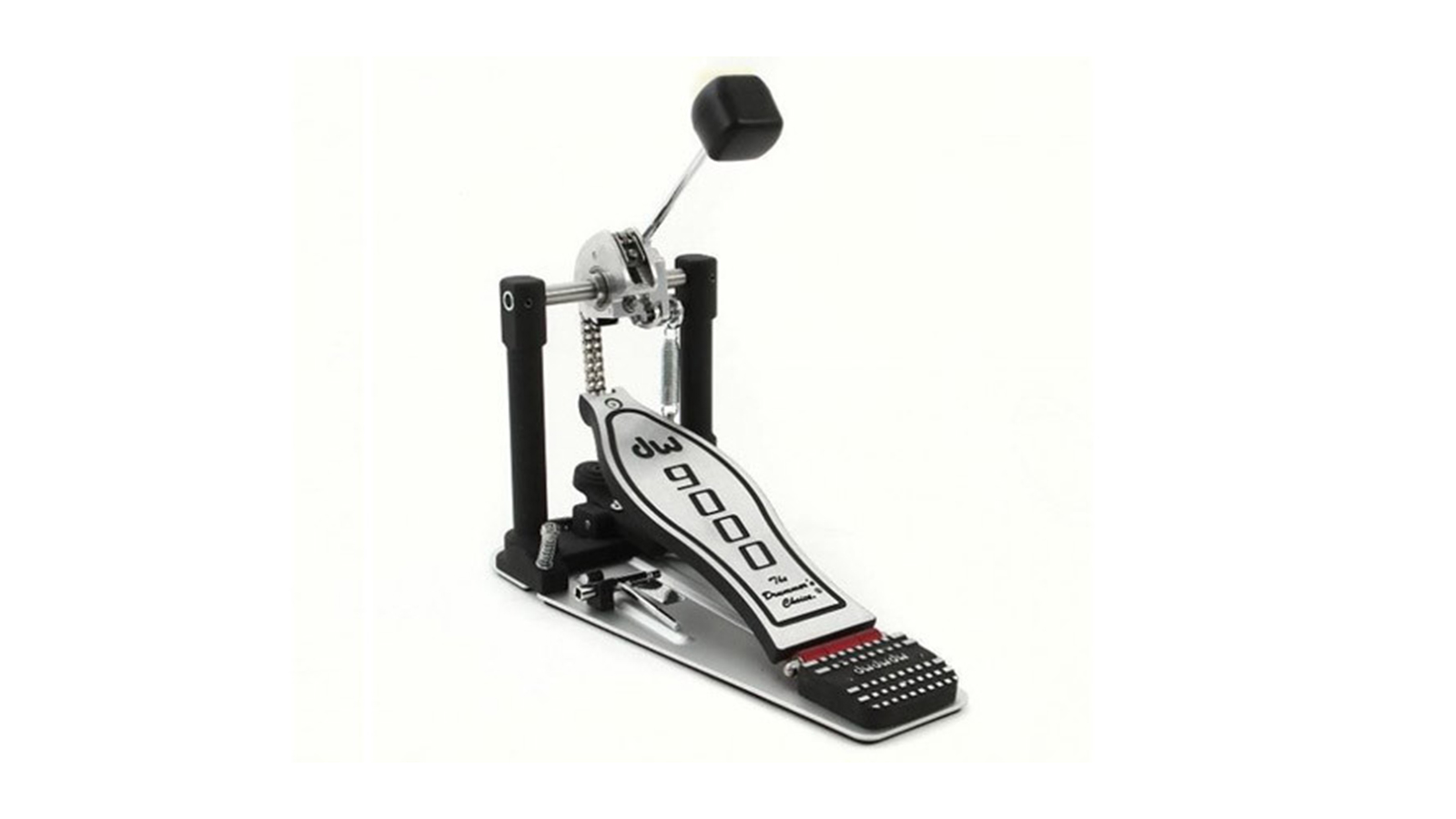
Specifications
Reasons to buy
Reasons to avoid
DW’s flagship 9000 hardware line gives us the 9000 series pedal - which sees it steal some thunder from the faithful 5000. A floating rotor, repositioned spring and near endless adjustment of the drive cam between Accelerator and Turbo settings means that you can really dial in the 9000’s feel.
And if that wasn't enough, DW offer a Pedal Customising Kit with footboard weights and stacker heels with which to adjust the response of the 9000s even further. A nine-position Elevator Heel Plate arrangement is arrived at through the use of three different-sized heel sections that can be used in conjunction with one another - the higher the stack, the greater the control.
So, how do they handle? Well, quite frankly, they're a joy to use. These pedals offer wonderful responsiveness and a grace and elegance that is pretty much unbeatable. Both pedals are rock solid in operation and give the impression that they are working with you.
Read more: DW 9000 series pedal review
Best direct drive
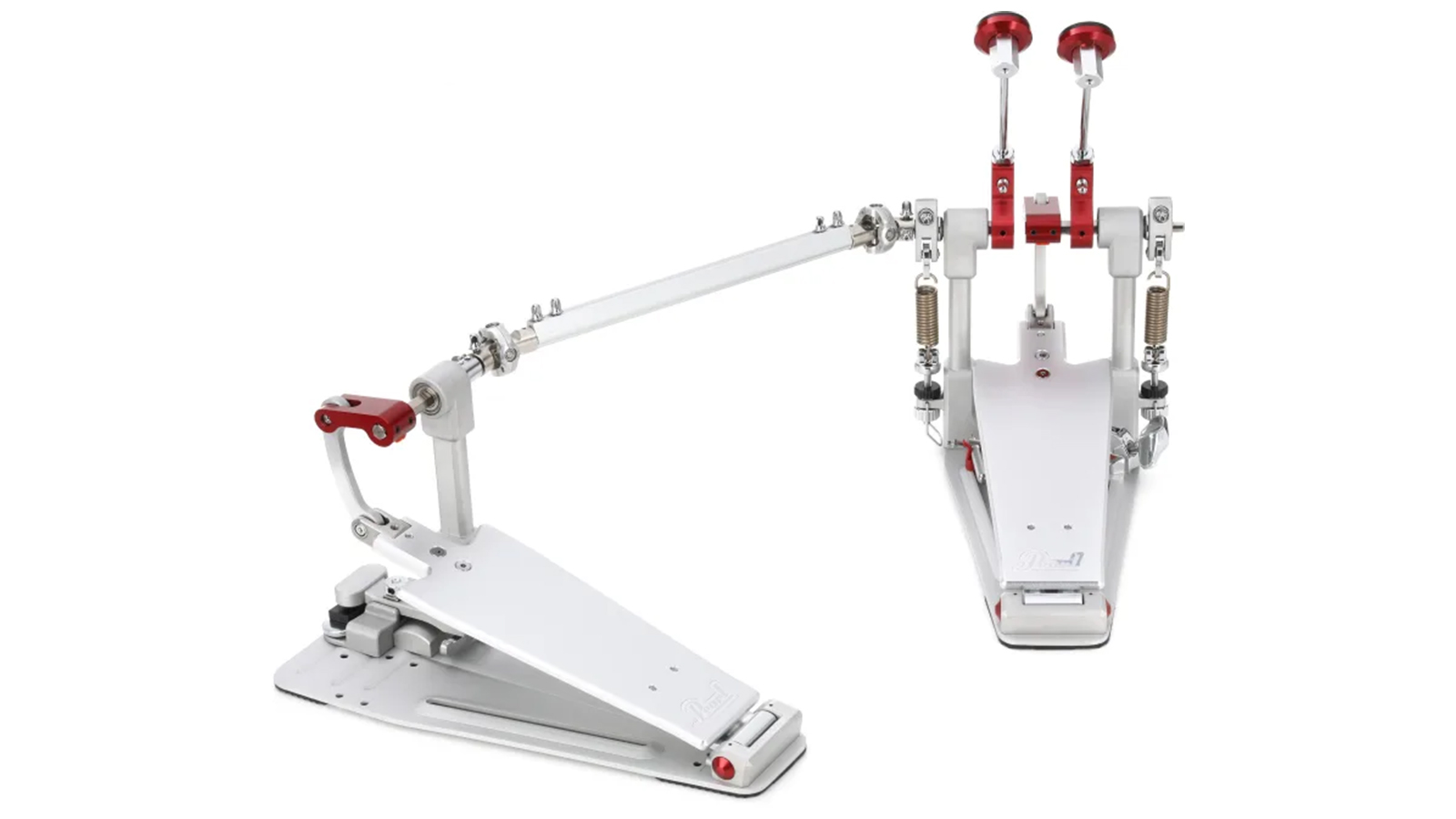
8. Pearl P-3500D Demon XR
Our expert review:
Specifications
Reasons to buy
Reasons to avoid
The Pearl Demon Drive XR feels like the natural evolution of the Trick Pro pedals that were released years ago. It has the same sleek, machined aluminium design and features a best-in-class direct drive unit, with an emphasis on speedy play and fluid motion.
Furthermore, the Pearl Demon XR uses an extreme high tension spring, which is noticeably larger, faster and heavier duty than the normal spring (which also comes included, for those who are not looking to play at Sonic The Hedgehog speeds).
The spring also features a click-lock, which stops the tension from changing, no matter how hard you play. The extreme impact beater is perfectly suited for a hefty, clicky tone that will perfectly suit rock and heavy metal drummers; especially in a live context.
Built to the highest modern standards whilst taking inspiration from the best direct drive pedals that came before it, the Demon Drive XR is everything a high octane drummer needs. Not to mention it looks sleek and beautiful. Yes, these are geared towards metal players, but if that’s your bag - look no further!
Best for simplicity

9. Sonor Perfect Balance Standard bass drum pedal
Our expert review:
Specifications
Reasons to buy
Reasons to avoid
Sonor’s Perfect Balance Standard pedal takes the blueprint of Jojo Mayer’s signature pedal and simplifies it further. It’s a belt-driven pedal, available as a single pedal only and Sonor has done away with the folding mechanism of Jojo’s signature pedal. Other changes include an un-etched heel plate, and an un-polished footboard.
What remains is the same drive design, which aims to deliver the, ahem… perfect balance between the beater’s forward motion and rebound. The Perfect Balance mirrors your foot movement for a silky-smooth action that’s a great option for those looking for a pedal without too many bells and whistles, while maintaining high-level performance.
Read more: Sonor Perfect Balance pedal review
Also tested
PDP Concept
The Concept Series pedals are available as chain-drive and direct-drive models. As well as the striking cobalt blue drive linkage, features include XF extended brushed aluminium foot boards, offset toe clamps, retractable spurs, DW air beaters, DW spring rocker adjustment, lightweight black aluminium baseplates and needle bearing hinges. The direct drive Concept pedals look great and are comfortable to play. Probably best suited to the mid-level player looking for an upgrade, or as a great first-foray into the world of direct drive pedals.
Read more: PDP Concept review
Trick Pro 1-V
Trick’s Pro 1-V is a sleek-looking, modern direct-drive pedal built from machined aluminium. A compression spring sits at the heart of the pedal’s feel, and all moving points incorporate ball bearings to maximise the smooth action of the pedal. The refreshingly easy manner in which you can set up and alter the feel of the Pro 1-Vs makes them of real interest to anyone with a pocket to cope with the prices. Yes, these are expensive propositions, but cutting-edge design and engineering never came cheap.
Read more: Trick Pro 1-V review
Mapex Falcon
For heels-up players, these pedals are ideal. The slim footboard is great for pulling your toes half-way down the board and stomping. It almost wills you to play faster. While for heels-down we found if we shoved our toes up under the stop our average size 9s sat perfectly on the heel plate for comfort. The Falcon has plenty of adjustment - including spring tension, beater angle, footboard angle - and manages to feel effortless, smooth and silent of action.
Read more: Mapex Falcon review
How to buy the best bass drum pedal for you
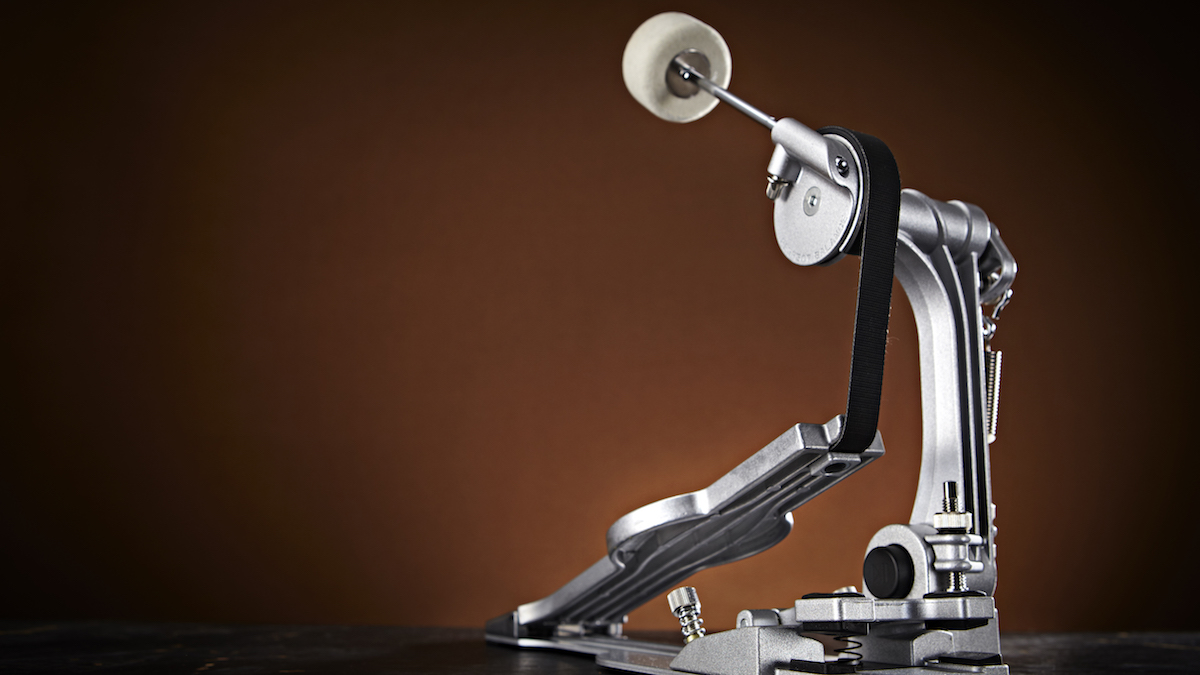
Before you decide which pedal to go for, there’s a few common questions you should ask yourself to help filter down to what you need.
What style of music do you play?
This dictates almost every decision you’ll make around which bass drum pedal you go for. While there are no hard and fast rules, jazz players will typically want something lighter and more responsive to lighter playing, while rock players will demand something sturdier with plenty of power for burying the beater and feels rock solid underfoot for chunky backbeats. Meanwhile, metal drummers or more technical players will need something ultra responsive and built to last the sheer number of notes that will be played.
Do you need a single or double pedal?
The last point leads directly into this… Anyone can use a double pedal, but you need to ask yourself whether you actually need one - they’re more expensive, more complicated to work into your setup, plus they’re physically heavier and larger to transport. So, if you play a few doubles here and there, with the right technique a single pedal will be plenty for the job. Meanwhile, for blazing 16th note blasts, a double pedal will be the only tool for the job.
How much adjustability do you need?
Honestly, almost every pedal you come across will have a certain degree of adjustability, from spring tension to footboard angle. And this will be plenty for most players. But if you want to fine-tune like a pro athlete, there are pedals that offer almost infinite adjustability and customisation of things like drive type, cam style, beater weight and more.
Will you be gigging with it?
Gigged pedals are exposed to much greater pressures than those that are exclusively played at home, so it pays to invest in something that will go the distance. For starters, you’ll want a sturdy pedal frame/construction, robust chain or direct drive setup and a trustworthy bass drum hoop clamp. Adrenaline-fuelled gigging drummers usually play that little bit harder, whilst venues can throw up extra stresses on your gear, from beer and water spillages, to changes in humidity, and a range of floor surfaces. Not to mention the fact your pedals will be carted in and out of vehicles, dumped in corners in between sets and possibly even used by other drummers in a kit-share scenario. So yeah, build quality should be your number one priority if you plan on playing live.
What’s your budget?
Pedals can get very expensive very quickly, so be sensible about your current and future needs and invest accordingly. We would prioritise built quality over adjustability, unless you’re really into fine-tuning things to the nth degree. Most pedals will offer a degree of adjustability to suit your playing style anyway, but not all will be built to last.
FAQs
Why are bass drum pedals so important?
The bass drum is the heavy, thudding presence that grounds and solidifies drum beats. Initially played with handheld mallets, it wasn’t until the early 1900s when William F. Ludwig’s company (yes - that Ludwig) created the first successful bass drum pedal. This allowed drummers to play hands-free, meaning that deep heavy presence could be accomplished by one person. Naturally, the way drum kits were played has changed significantly since the invention of the pedal, birthing genres like funk, rock, metal and hip-hop.
Do you need a single or double bass drum pedal?
Bass drum pedals come in two different types: single or double. Much like which technique to use, it can be difficult to ascertain which is the best fit for you. The two types do have subtly different use cases, so if you're struggling to decide, here are a few things you should take into consideration.
The first thing to consider is the kind of music you play. While double kick techniques can be applied across multiple genres, most drummers who opt for a second pedal do so to maintain speed in more extreme styles like metal and thrash. If you don’t need that relentless low-end drive, then a double pedal might be more of a luxury than a necessity. That said, a double pedal does everything a single can - plus a whole lot more. If you want the extra flexibility, it’s a solid investment.
Ergonomics also play a crucial role. In our experience, adding a second pedal to the left side can interfere with hi-hat positioning - something to keep in mind if you’re interested in jazz, funk, or pop drumming. If you tend to keep your hi-hats locked open or closed, it’s a non-issue. But if dynamic hi-hat control is central to your playing, ask yourself: is shifting your setup worth it for something you might only use occasionally?
Almost all of the pedals in our guide are available in both configurations, including double pedal orientations for left-footed players - so there is a vast range of options.
What bass drum pedal drive options are there?
Once you’ve settled the single vs. double debate, the next big decision is drive type. This is the mechanism that links the footplate to the beater cam, directly affecting how efficiently your energy translates into motion. Drive types come in three main varieties: chain, belt, and direct drive.
Chain drives are the industry standard, found on most modern pedals - often reinforced with dual chains for added durability. Reliable, sturdy, and responsive, they’re a solid choice for most players.
Belt-driven pedals do the same job, and were the standard in early bass drum pedal design, offering less flex than a chain for a more consistent motion with less loss of momentum. Older belt designs were more fragile and prone to wear or even snapping, while modern-day equivalents are often made from stiff kevlar, making them quite literally bulletproof.
Finally, direct drive is the most efficient of the three. With a rigid connection between the footplate and beater, direct drive pedals react instantly to every movement, delivering an ultra-responsive feel. If you play fast styles like metal or punk and need a pedal that keeps up, this could be your best bet.
What do I need to know about spring tension?
Every bass drum pedal relies on a spring to return the beater to its starting position after each stroke. While it’s a standard feature rather than an optional one, the tension of that spring has a huge impact on how the pedal responds - arguably more than any other component.
Higher spring tension gives you a faster rebound, making it easier to execute rapid strokes. The trade-off is that it takes more effort to get the pedal moving in the first place. If speed is a priority, look for a pedal with a wide tension adjustment range. Some manufacturers even offer replacement springs with different levels of resistance, allowing you to fine-tune the response to suit your playing style.
What cam types are there?
The next thing to consider is the cam type. These come in two main forms - linear or offset. Linear cams are perfectly round, offering a smooth, consistent motion throughout the entire stroke. This provides a reliable and even feel, ideal for players seeking control and precision.
An offset cam, however, pulls the beater towards the head as it nears the end of its travel. This creates a lighter feel at the start but delivers more power at impact, offering a punchier attack without requiring extra effort.
Some pedals - such as the Pearl Eliminator - come with interchangeable or reversible cams, allowing you to try both options and find the one that works best for you.
Footboards and bass drum beaters
Finally, you’ll be met with different footboard lengths and beater options. Longer footboards offer more comfort, especially for players with bigger feet. While techniques like swivel or heel-toe can be done on any pedal, many prefer the extra surface and leverage a longboard provides for smoother action.
Beaters are the easiest and most affordable part to swap out. They come in various materials like felt, plastic, and wood, and profiles such as round, flat, or ridged. Some pedals feature dual-surface beaters, with felt on one side for a softer attack and plastic on the other for a sharper sound.
Certain pedals - such as the Yamaha FP9 - offer even more versatility with beaters that have multiple surfaces and adjustable weights, allowing you to tailor the feel and sound. While the beater does affect the pedal’s response, it’s usually best to focus on other components first, as beaters are easily swapped depending on the style or sound you need. Many drummers keep several on hand for different genres.
What key bass drum techniques should I know about?
Foot strength and technique differs person-to-person and will be genre dependent. For example, jazz drummers will use the hi-hat on every other beat, since the hi-hat is the time-keeper. With this type of left foot action, the right foot tends to focus on more accented, often simpler patterns, or even a technique called ‘feathering’, which involves playing the kick drum softly on every beat. This is a vestige of old jazz recordings, which only had one microphone, so the low end wasn’t very pronounced and the drummer had to play this way to help accentuate the bass player’s part in the recording.
While there is no “proper” way to use a bass drum pedal, there are multiple commonly used techniques with different benefits and drawbacks. Naturally, different styles of drumming call for different techniques, too.
‘Heel up’ technique involves using the ball of the foot to press down on the pedal, with your heel extended upwards, so as to obtain a powerful and concise hit from the beater to the drum skin.
‘Heel down’ is, as the name suggests, the same, with the drummer’s heel flat to the bottom of the pedal. This is less powerful than heel up, but allows for soft playing, perfect for jazz; especially for those using the feathering technique.
‘Heel-toe’ technique uses a rocking motion for fast double strokes. The heel presses down for the first hit, followed by the toe pushing forward for the second. This technique is great for playing triplets and semiquavers, making it ideal for fast genres like metal and funk.
Finally, the ‘swivel’ technique uses ankle rotation for fast, controlled strokes. It’s a lighter, more efficient way to play, relying on foot movement rather than the whole leg. Often combined with heel-toe, it boosts speed and precision.
How we choose the best bass drum pedals for this guide
Here at MusicRadar, we are experts in our field, with many years of playing, creating and product testing between us. We live and breathe everything music gear related, and we draw on this knowledge and experience of using products in live, recording and rehearsal scenarios when selecting the products for our guides.
When choosing what we believe to be the best bass drum pedals available right now, we combine our hands-on experience, user reviews and testimonies and engage in lengthy discussions with our editorial colleagues to reach a consensus about the top products in any given category.
First and foremost, we are musicians, and we want other players to find the right product for them. So we take into careful consideration everything from budget to feature set, ease of use and durability to come up with a list of what we can safely say are the best bass drum pedals on the market right now.
Find out more about how we test music gear and services at MusicRadar.
Why trust us?

☑️ Established 2007
☑️ 2.9 million monthly users globally
☑️ 9,500+ reviews on-site
With more than 18 years of experience, MusicRadar is the premier music-making website in the world. Run by musicians for musicians, we offer indepentl, expertly written gear round-ups and high-quality, authoritative reviews by an extensive team of highly experienced industry professionals.
Our testing team includes:
- Expert reviewers with decades of combined hands-on experience testing, playing and owning a wide range of drum gear with a deep understanding of how the industry has evolved.
- Industry professionals who have worked in the drum/music industry for decades, including Editor positions at leading drumming magazines and websites.
- Our team also includes drum teachers, function drummers, band drummers and players who have worked in drum shops.
Latest updates
30/04/25: This guide has had a significant overhaul. Changes include an update/streamline of the product list and we've given each pedal a 'best for' label so it's easy to decipher which pedal is right for you. Additionally, we've added more comprehensive how to buy and FAQ sections loaded with advice from our drum gear experts.
Read more:
MusicRadar's got your back
- Find your voice with one of the best snare drums
- Plug into the best electronic drum sets you can buy
- Just starting out? These are the best beginner electronic drum sets
- On a budget? Explore the best beginner drum sets around
- Need new metals? Start with our guide to the best cymbals
- The best electronic drum pads: percussion pads for the studio and stage
- Show the drummer some love with these gifts for drummers
Want all the hottest music and gear news, reviews, deals, features and more, direct to your inbox? Sign up here.

Stuart has been working for guitar publications since 2008, beginning his career as Reviews Editor for Total Guitar before becoming Editor for six years. During this time, he and the team brought the magazine into the modern age with digital editions, a Youtube channel and the Apple chart-bothering Total Guitar Podcast. Stuart has also served as a freelance writer for Guitar World, Guitarist and MusicRadar reviewing hundreds of products spanning everything from acoustic guitars to valve amps, modelers and plugins. When not spouting his opinions on the best new gear, Stuart has been reminded on many occasions that the 'never meet your heroes' rule is entirely wrong, clocking-up interviews with the likes of Eddie Van Halen, Foo Fighters, Green Day and many, many more.


